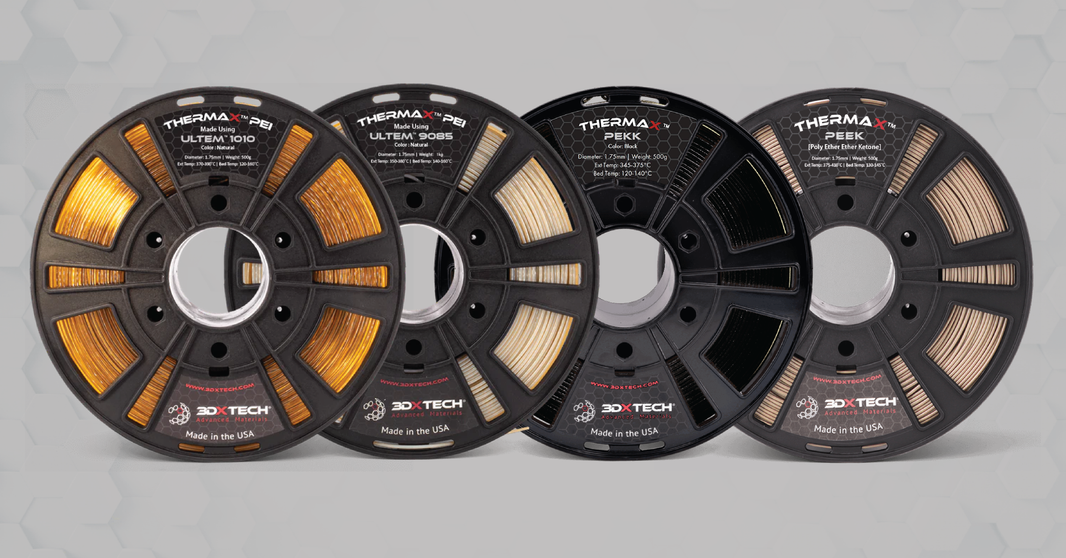PEEK vs PEKK vs ULTEM: Choosing the Right Ultra-Polymer for 3D Printing
When it comes to high-temperature 3D printing materials, few can compete with the advanced properties of PEEK, PEKK, and ULTEM filaments. These ultra-polymers are trusted in industries such as aerospace, automotive, defense, manufacturing, and oil & gas where mechanical strength, chemical resistance, and thermal stability are mission-critical.
In this article, we’ll compare PEEK vs PEKK vs ULTEM, exploring their strengths, applications, and how engineers can choose the right material for jigs, fixtures, tooling, prototypes, and end-use parts.
Why Ultra-Polymers for Additive Manufacturing?
Unlike standard thermoplastics, engineering-grade filaments like PEEK, PEKK, and ULTEM offer superior performance. Their benefits include:
- High thermal resistance, suitable for extreme environments
- Exceptional strength-to-weight ratios compared to metals
- Resistance to chemicals, fuels, and harsh operating conditions
- Compliance with aerospace and defense standards
- Longevity in high-wear manufacturing applications
These characteristics make them ideal for industries needing reliable additive manufacturing solutions that go beyond prototyping.
PEEK Filament
PEEK (Polyether Ether Ketone) is one of the strongest and most recognized engineering filaments. It offers exceptional strength, chemical resistance, and thermal stability up to 250°C, making it a go-to choice for high-performance applications.
Applications:
- Aerospace: Lightweight, durable end-use parts and structural components
- Automotive: High-strength prototypes and under-the-hood components
- Oil & Gas: Chemical-resistant seals, valves, and connectors
- Manufacturing: Wear-resistant jigs and fixtures
PEKK Filament
PEKK (Polyether Ketone Ketone) belongs to the same family as PEEK but offers improved processability and greater resistance to thermal oxidation. It prints with reduced warping, making it attractive for engineers seeking performance with improved printability.
Applications:
- Defense: Heat-resistant and chemically stable components
- Aerospace: FAA-compliant interior parts and tooling
- Manufacturing: Functional tooling and end-use parts
ULTEM (PEI) Filament
ULTEM (Polyetherimide) is another high-performance thermoplastic known for its balance of strength, heat resistance, and cost-effectiveness compared to PEEK and PEKK. Available in grades like ULTEM 9085 (aerospace-certified) and ULTEM 1010 (FDA compliant), it’s one of the most versatile industrial 3D printing filaments.
Applications:
- Aerospace: FAA-certified interior parts with flame, smoke, and toxicity compliance
- Automotive: Heat- and fuel-resistant prototypes and end-use parts
- Medical & Food Processing: Applications requiring FDA-compliance (ULTEM 1010)
- Manufacturing: Tooling and fixtures with high thermal performance
PEEK vs PEKK vs ULTEM: Key Comparisons
| Property | PEEK | PEKK | ULTEM |
|---|---|---|---|
| Heat Resistance | Up to 250°C | Up to 260°C | Up to 217°C |
| Printability | Challenging, prone to warping | Improved, less warping than PEEK | More forgiving, cost-effective |
| Strength | Exceptional tensile and impact strength | Comparable to PEEK, with added oxidation resistance | High strength, slightly lower than PEEK/PEKK |
| Cost | Highest | High | More affordable |
| Industries | Aerospace, Oil & Gas, Automotive | Aerospace, Defense, Manufacturing | Aerospace, Automotive, Medical |
Conclusion: Which Material is Right for You?
Deciding between PEEK, PEKK, and ULTEM filaments comes down to balancing performance, printability, and cost.
- Choose PEEK filament for the most demanding environments and maximum performance.
- Choose PEKK filament when you need similar strength with improved printability.
- Choose ULTEM filament for cost-effective, certified solutions in aerospace, automotive, and medical applications.
By leveraging these high-temperature 3D printing materials, engineers can replace metals, optimize manufacturing workflows, and produce reliable end-use parts across critical industries.






